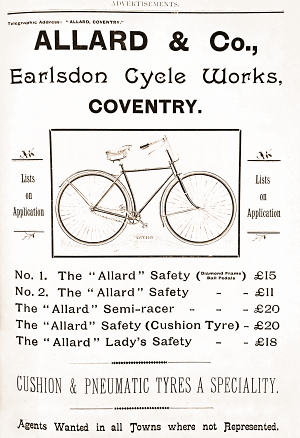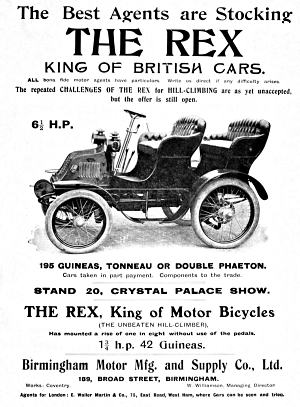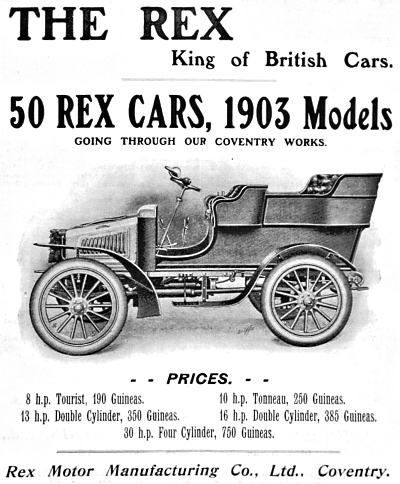|
Index...
|

 he "Rex" story is a really quite a complicated one, so if you can, please do bear with me. The name emerged out of a couple of previous West Midlands concerns from the late Victorian era, and ended some 30 years later in almost a weird tangled web of take-overs and off-shoot companies - but still, I will attempt to dissect and reconstruct its history, whilst highlighting its place as significant early British motor pioneers.
he "Rex" story is a really quite a complicated one, so if you can, please do bear with me. The name emerged out of a couple of previous West Midlands concerns from the late Victorian era, and ended some 30 years later in almost a weird tangled web of take-overs and off-shoot companies - but still, I will attempt to dissect and reconstruct its history, whilst highlighting its place as significant early British motor pioneers.

One could well argue that the very foundations of Rex fell at the feet of a certain Frederick William Allard. Born at Northampton in 1863, by 1880 Allard was working at the Coventry Machinists Company (CMC), cycling from his home at Northampton to Coventry and back each day. As a keen cyclist, the weekly coverage of such miles clearly paid off, and by the age of 25 Allard had become a professional cycle racer, eventually rising to the rank of 'safety champion of the world'.
Off the back of his many successes and prize wins, in 1889 Allard formed his own cycle manufacturing firm as 'Allard & Company' at Moor Street, Earlsdon, Coventry, in partnership with ex-CMC colleagues Benjamin Done (b. 1854) and George Pilkington (b. 1861). Allard himself, it seems, did not stick around too long for some reason, selling off his part in the business in the November of the following year, most probably retaining certain royalties. He soon after became licensee of the Hare & Squirrel on Cow Lane, whilst Pilkington and Done further developed the Allard business, becoming a limited liability company by April 1891.
Following the departure of Benjamin Done about 1893, Pilkington's extended family stepped in to become major shareholders, and a new larger factory was erected on Providence Street, Earlsdon, in 1896. As reputable bicycle manufacturers, by 1899, Allard & Co., had exhibited two motor-powered 'Allard' tricycles at London's Agricultural Hall, and from that point onwards, pedal power was pretty much displaced by the firm in favour of motive power. In March 1902, Allard & Co., acquired the assets of the newly formed Birmingham Motor Manufacturing & Supply Company, of which had strong family ties to Allard co-founder George Pilkington - the only one of the founding three remaining. This firm built the first 'Rex' Motors at Earlsdon, and by June 1902 the title of the business changed to that of the Rex Motor Manufacturing Co., 'Rex' of course, being the Latin word for 'King'.

William Williamson (b. 1873), who himself began at Allard & Co., in 1892, was given the managing director role of the firm, and initially, promoting themselves as the 'King of Motors', they were turning out some 4-5 machines per week. Cyril Owen (b. 1876) was given the role of sales manager, and Frederick William Barnes (b. 1867) as designer/draughtsman, and an impressive range of well-turned out motorised vehicles followed - chiefly in the form of varied sized cars, motor-bicycles, and forecars. However, out of all their products, it was the motorcycles that became their bread and butter, having been regular's at all national racing and reliability events, including the Isle of Man TT. From around 1905/06, motor cars suddenly became their focus - presumably because there was more money to be made - but it would be a decision they would possibly later regret.

By this time, William's younger brother Harold Walter Williamson (b. 1879) was managing all Rex Sales, and often, the completion of sales was not without difficulty. In the summer of 1911, the company took legal proceedings against a wealthy provision importer of Beeston, Nottinghamshire, named Joseph Bostock. Bostock had visited the national motor show at Olympia the previous November, and had been struck by the appearance of a 15hp Rex motor car. Having paid a deposit on the £350 machine (around £28K now), a test drive was later arranged at Beeston, but following the unconvincing run whereby the car seized a number of times, Bostock unsurprisingly revoked on the purchase. Although the company were legally successful in Court, they were only awarded £25 with costs, and as a result, Rex made no more cars thereafter.
Incidents such as this must have caused frustration and upset back at the factory in terms of the blame game, both at ground and board level, and indeed after a boardroom bust up a few weeks later, the Williamson brothers had both resigned. Harold quickly obtained work in a similar vein at the Singer Co., and William, perhaps as a parting shot towards George Pilkington et al, set himself up as a motor manufacturer just a stone's throw from the Rex Works at Cromwell Street, under the title of the Williamson Motor Co., backed by his relations, the Douglas family of Bristol.

 he Rex concern, now mostly owned by the extended Pilkington family, regrouped and carried on with purpose, even enlarging the Earlsdon Works as a show of ambition. They continued to attend the national motor shows, yet only with regards to motorcycles, and by the 1913 show, they only exhibited one model - the Rex Sidette De Luxe motorcycle combination. This may just have brought a wry smile to the face of William Williamson, who also happened to be exhibiting at the show with a full range of his own Douglas-powered 'Williamson' machines.
he Rex concern, now mostly owned by the extended Pilkington family, regrouped and carried on with purpose, even enlarging the Earlsdon Works as a show of ambition. They continued to attend the national motor shows, yet only with regards to motorcycles, and by the 1913 show, they only exhibited one model - the Rex Sidette De Luxe motorcycle combination. This may just have brought a wry smile to the face of William Williamson, who also happened to be exhibiting at the show with a full range of his own Douglas-powered 'Williamson' machines.
By the time War was announced in August 1914, the Rex Motor Manufacturing Co., was in really bad shape. A meeting of creditors revealed that the business had never really recovered from investing too much time and money into a particular motorcar model all the way back in 1907, but had kept on going with the hope of turning things around. The universal opinion of the advisory committee, was a reconstruction scheme, and so in early 1915 a new company was incorporated, this time as the Coventry Acme Motor Co. Ltd, the 'Acme' part being of Greek origin, meaning something that's the very best it can be. The first directors were actually Arthur Pilkington (b. 1863), and William Pilkington Jnr (b. 1884), George's younger brother and nephew, respectively. The managing director role fell on the shoulders of former Rex-employee George Henry Hemingway (b. 1884), John Earnshaw (b. 1867) became his deputy, and the Irishman William John Robb (b. 1860) assisted with technical design.
Inevitably, a number of staff signed up for active service, yet the company were fortunate to obtain a large contract with the War department to keep them more than busy, turning out motor and lorry brake cams/blocks and gudgeon pins, and even supplying shell noses to the French government.



At the conclusion of War, the Coventry Acme directors decided to relaunch the famous 'Rex' brand, offering a new range of motorcycles whilst trading both as the Coventry Acme Motor Co., and the Rex Motor Manufacturing Co. Ltd. Initially, they began by offering the 'Rex Model 77' motorcycle, but by 1920, they were offering motorcycles separately under both the 'Rex' and 'Acme' names. The very next year, just the Rex Motor Manufacturing Co. Ltd., appeared at Olympia, this time offering a range of 'Rex-Acme' machines, and then by 1922, things got more confusing. Again, only the Rex Company exhibited, but this time providing their address as St. Patricks Road, Coventry, rather than their familiar Earlsdon factory, offering 'Maxim' and 'King' bicycles, but also four 'Rex-Acme' motorcycles, powered by either JAP, Blackburne, or Barr & Stroud engines. So why the sudden change of address? Why were they now making bicycles again?
Well, the St. Patricks Road factory, actually belonged to the Hobart Cycle Co. Ltd., which had origins in Coventry going back to 1877. As well as cycles, they had also made motors from the turn of the century, but also acquired a few trade names along the way. They too exhibited at the 1922 Olympia Show with 'Hobart' cycles, but also motorcycles, and like the Rex-Acme machines, were powered by the same engines.
Clearly then, Hobart had at some point acquired a stake in Coventry Acme/Rex, and indeed by August 1923, George Hemmingway of the Coventry Acme Motor Co., held a meeting with all creditors regarding winding up the firm. The outcome was the launch of yet another concern, this time called Hobart Acme Motors Ltd., and at Olympia in the November of the same year, Hobart-Acme Motors exhibited, offering 'Hobart' cycles and motorcycles, 'Maxim', 'King' and 'Acme' cycles, and also 'Rex-Acme' motorcycles.


 fresh start then? Well not quite, as in April 1924, Hobart-Acme Motors Ltd was up for sale as a going concern, which included all the goodwill, trade names, stock, plant and machinery. The purchaser was a certain William Henry Fulford (b. 1862), the maker of 'Millford' sidecars with connections in Coventry's cycle trade going back to the late 1890s, and on moving the production of Rex-Acme machines to Stoney Stanton Road, he now had a factory making popular sidecars, reputable cycles, and a well-established motorcycle brand. It was a decent bit of business too, as in 1925, their competition manager/works rider Walter Handley (1902-1941) won both the Junior and Ultra-Lightweight events at the Isle of Man TT, and returned a local hero with his Rex-Acme machines, really helping to boost sales.
fresh start then? Well not quite, as in April 1924, Hobart-Acme Motors Ltd was up for sale as a going concern, which included all the goodwill, trade names, stock, plant and machinery. The purchaser was a certain William Henry Fulford (b. 1862), the maker of 'Millford' sidecars with connections in Coventry's cycle trade going back to the late 1890s, and on moving the production of Rex-Acme machines to Stoney Stanton Road, he now had a factory making popular sidecars, reputable cycles, and a well-established motorcycle brand. It was a decent bit of business too, as in 1925, their competition manager/works rider Walter Handley (1902-1941) won both the Junior and Ultra-Lightweight events at the Isle of Man TT, and returned a local hero with his Rex-Acme machines, really helping to boost sales.
Fulford became the overall controller, with Tom Bramley (b. 1874 - ex-Coventry Challenge Co.) as managing director, Lawson Clarke (b. 1888) as works manager, and Walter Tunnercliffe (b. 1887) as chief motor engineer. They continued to exhibit at the annual show at Olympia each year, but by 1927 they ceased to show any cycles as, just like back in the early Rex days, board level disagreements flared up once again. The original pact made between Fulford and Bramley in 1924, was that Bramley would be paid a yearly salary of £1,000 for seven years, and eventually become overall owner, buying out Fulford' s shares. However, by 1926, Fulford, who also had a big stake in the coachbuilding firm of Hollick & Pratt, wanted out sooner because of another business proposition he had received. Bramley wasn't in a position to find the sum of money required, and so declined, by which Fulford reacted by offering Bramley new terms in his current role, which included a £400 per annum drop in salary. Bramley rejected the offer and resigned.
By 1929, only the Rex Motor Manufacturing Co. Ltd., appeared at Olympia, displaying no less than 14 Rex Acme machines. The following year it was announced that both Mills-Fulford and Rex would be present, yet at the very last minute, for whatever reason, neither showed up. That, it seems, was the beginning of the end, as neither attended Olympia in 1931, and there was no show staged in 1932. It did reconvene by 1933, however again, there was no sign of Mills-Fulford or Rex. Then out of the blue in 1934, Mills-Fulford reappeared with a range of 8 sidecars, yet significantly, a John T. Chaplin (b. 1903), a chartered accountant by profession, was given as the receiver of the firm, pretty much an indication of a clearance sale.

It was not until 1937 that Mills-Fulford Ltd., was eventually struck of the register at Companies House, most probably as this was the same year that William Henry Fulford died. The Rex Motor Manufacturing Co. Ltd., was actually struck off the year before, and Fulford's other concerns, Hobart, Maxim and Fulwell, all went in 1934. So although Mills-Fulford, Rex, and Hobart were all seen listed in the 1935 Coventry Trade Directory at Stoney Stanton Road, I can see no real evidence to suggest that any Rex-Acme machines were made after 1933, and I think cycle production ground to a halt soon after, and sidecars were certainly finished by 1936/37.

So, what became of the original founders of this eventual tangled web of businesses and factories spanning some 45 years? Allard, Pilkington, and Done?
Not much is known about Benjamin Done. Like Allard he did not stick around for long at Allard & Co., and a couple of years later was instead in partnership with George Shuttleworth at Days Lane, Coventry, making cycle parts. After that, he's a really difficult one to track, but I think was largely Birmingham-based.
With regards to Fred Allard, he remained local and owned/ran a string of pubs in the city over the following decades including the Hare & Squirrel, the Peeping Tom, and the Market Vaults. He retired to nearby Burton Green in the 1930s, and sadly, in 1939 was the driver of a car of which blew a tyre and overturned resulting in the death of his wife. He himself died in 1943.
And finally, George Pilkington, who was really the one that made the Rex name famous, not to mention responsible for numerous design patents along the way. I think his overall connections to Rex ended at the beginning of the First World War, but he did later set up a motor transport business called G. Pilkington & Son. He became engaged in local politics from 1910 as a Liberal Councillor for the Hearsall Ward, and died at his home on Allesley Old Road in March 1921, leaving a widow and eight children.
And that's the complicated, yet I hope interesting, story of Rex. In terms of British motoring names, they weren't the biggest, and they certainly weren't the best known, but undeniably they were completely in the thick of it when looking back to the very early and innovative days of British motor manufacturing.
Damien Kimberley, January 2020.
For further information on Coventry's motor and cycles trades, please take a look at my three books on the subjects: Coventry's Motorcycle Heritage, Coventry's Motorcar Heritage, and Coventry's Bicycle Heritage.
Website by Rob Orland © 2002 to 2025